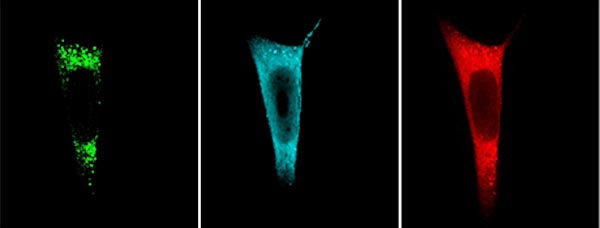Analysis of Complex Protein Interactions

Picture: Isabel M. Schopp, Heidelberg University Biochemistry Center Confocal microscopy image showing human cells expressing two interacting proteins (green and blue). Split-BioID labels additional proteins belonging to the same complex (red).
The composition of specific functional protein complexes in their cellular environment can now be analysed with unprecedented resolution. The team led by junior group leader Dr Julien Béthune at Heidelberg University Biochemistry Center has developed a new technique which allows the scientists to overcome a long-standing hurdle in molecular cell biology.
The method called “split-BioID” allows them to analyse context-dependent protein complexes which could not be identified previously. Their research results were published in the journal “Nature Communications”.
The genome of living organisms encodes tens of thousands of proteins that perform most cellular functions. To fulfil their tasks, the proteins must interact to form large macromolecular assemblies. The identification of protein-protein interactions within such complexes has thus been a crucial task in the field of molecular cell biology. But a major challenge comes from the dynamic nature of these assemblies.
“Typically, a single protein is part of several distinct and often overlapping complexes that remodel according to the cellular context and the physiological function to be exerted,” explains Dr Béthune. “To date, the lack of analytical techniques with sufficient resolution prevented easy assignment of protein-protein interactions to specific functional complexes.”
In their research, the scientists combine two existing approaches: an assay called BioID to identify possible protein-to-protein interactions with labelling techniques and the concept of the “Protein-Fragments Complementation Assay” (PCA), a method to validate interactions between two proteins.
“In comparison with conventional methods, the novel ‘split-BioID’ provides outstanding spatio-temporal resolution that enables easy analysis of context-dependent protein complexes,” emphasises Isabel Schopp, a PhD candidate in the Béthune research group and primary author of the study. The researchers are now hoping to gain a better understanding of how cells dynamically react with their environment.
Julien Béthune is a member of the CellNetworks Cluster of Excellence at Heidelberg University, and his research at the Biochemistry Center focuses on the mechanisms of posttranscriptional gene silencing by miRNAs, and their interaction with endomembranes.
Original publication:
I.M. Schopp, C.C.A. Ramirez, J. Debeljak, E. Kreibich, M. Skribbe, K. Wild, and Julien Béthune: Split-BioID a conditional proteomics approach to monitor the composition of spatiotemporally defined protein complexes. Nature Communications 8:15690 (published online 6 June 2017), doi: 10.1038/ncomms15690
Contact:
Dr Julien Béthune
Heidelberg University Biochemistry Center
Phone +49 6221 54-4749
julien.bethune@bzh.uni-heidelberg.de
Communications and Marketing
Press Office, phone +49 6221 54-2311
presse@rektorat.uni-heidelberg.de
http://bzh.db-engine.de/default.asp?lfn=2241&fg=4268&setLang=en
http://www.uni-heidelberg.de/presse/news2017/pm20170609_analysis-of-complex-prot…
Media Contact
All latest news from the category: Life Sciences and Chemistry
Articles and reports from the Life Sciences and chemistry area deal with applied and basic research into modern biology, chemistry and human medicine.
Valuable information can be found on a range of life sciences fields including bacteriology, biochemistry, bionics, bioinformatics, biophysics, biotechnology, genetics, geobotany, human biology, marine biology, microbiology, molecular biology, cellular biology, zoology, bioinorganic chemistry, microchemistry and environmental chemistry.
Newest articles

Silicon Carbide Innovation Alliance to drive industrial-scale semiconductor work
Known for its ability to withstand extreme environments and high voltages, silicon carbide (SiC) is a semiconducting material made up of silicon and carbon atoms arranged into crystals that is…

New SPECT/CT technique shows impressive biomarker identification
…offers increased access for prostate cancer patients. A novel SPECT/CT acquisition method can accurately detect radiopharmaceutical biodistribution in a convenient manner for prostate cancer patients, opening the door for more…

How 3D printers can give robots a soft touch
Soft skin coverings and touch sensors have emerged as a promising feature for robots that are both safer and more intuitive for human interaction, but they are expensive and difficult…





















